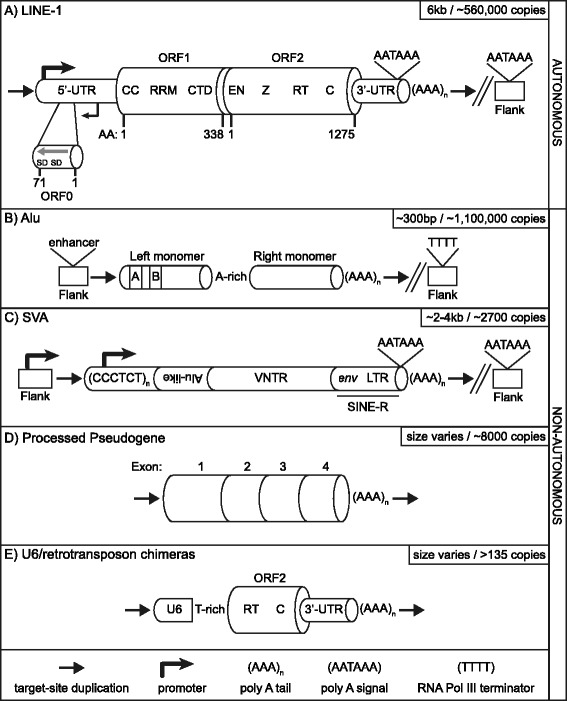Fig. 1.

Retrotransposons active in humans. a An autonomous active LINE-1. A full-length LINE-1 ~ 6 kb in length is shown [36, 41, 239]. LINE-1 encodes three proteins, two of which (ORF1p and ORF2p) are absolutely required for retrotransposition in cis [42, 146]. Currently, the role for ORF0p is unclear [60]; interestingly, it may form fusion proteins with downstream coding sequences by utilizing internal splice donor sites (SD) [60]. LINE-1 transcription is driven from its own promoter (big black bent arrow) [53, 54] located in the 5′-UTR. The 5′-UTR also encodes a weaker antisense promoter (ASP, small black bent arrow) [59]. It has been postulated that the LINE-1 ASP in conjunction, with splice acceptors located on the antisense strand of LINE-1, may contribute to new gene formation via a mechanism termed “gene-breaking [240].” Termination of LINE-1 transcription is mediated by a polyA signal (AATAAA) located in the 3′-UTR. Occasionally, transcription proceeds past the internal polyA signal and terminates at a downstream one [139, 241]. Such chimeric transcripts, if retrotransposed, may result in 3′-transductions [42, 62–64, 176]. Majority of insertions end in a polyA tail (AAAn) of variable length [37]. In addition, most insertions are characterized by flanking target-site duplications (4-20 bp in length, black horizontal arrows) [35]. CC-coiled coiled domain [47], RRM-RNA recognition motif [44], CTD-C-terminal domain, EN-endonuclease [51], Z domain [242], RT-reverse transcriptase [52], C-cysteine-rich. AA-amino acid. b The Alu SINE. Alus are small Pol III transcribed RNAs derived from 7SL RNA [243]. An Alu element consists of a left and right monomer, which are derived from an ancient duplication event, separated by an internal A-rich sequence. Alus contain their own transcriptional signals, an A and B box located in the left monomer. Efficient Alu transcription requires a strong enhancer element in the upstream flanking sequence [103, 104]. Transcription termination of an Alu typically occurs at a Pol III terminator (TTTT) located in the downstream flanking sequence [244]. Similar to LINE-1, Alu insertions end in a polyA tail and are flanked by a target-site duplication. c A canonical SINE-VNTR-Alu (SVA) element consisting of its primary domains: CCCTCT hexamer, Alu-like, VNTR, SINE-R derived from the env gene and right LTR from a HERV-K is shown [126]. SVA transcription can initiate upstream (black bent arrow) or in the CCCTCT hexamer (black bent arrow) [126, 127]. Like LINE-1, SVA transcription typically terminates at its own [127] or a downstream polyA signal [24, 65]. d A processed pseudogene (PP) is shown. Note the lack of introns and the presence of a target-site duplication and a 3′-polyA tail similar to LINE-1, Alu, and SVA. e U6 chimera insertion. A U6 snRNA fused with the 3′-end of an LINE-1 sequence formed by “template-switching” [84, 140, 144] is shown. Although the site where ORF2p switches templates varies across the U6 chimera insertions, the junction where the two sequences are joined is typically T-rich [144]
